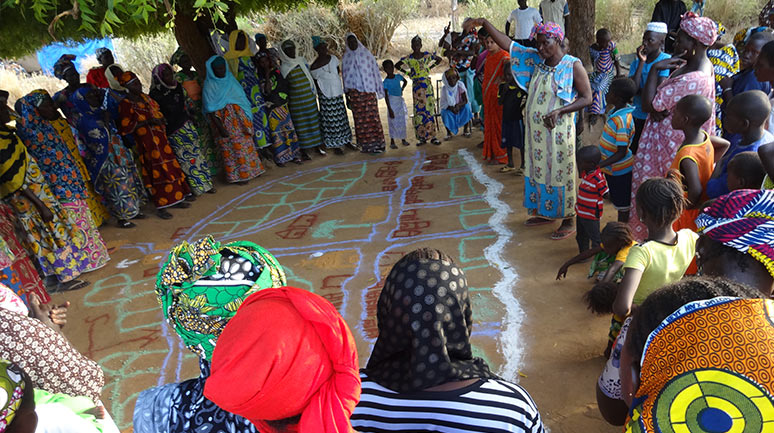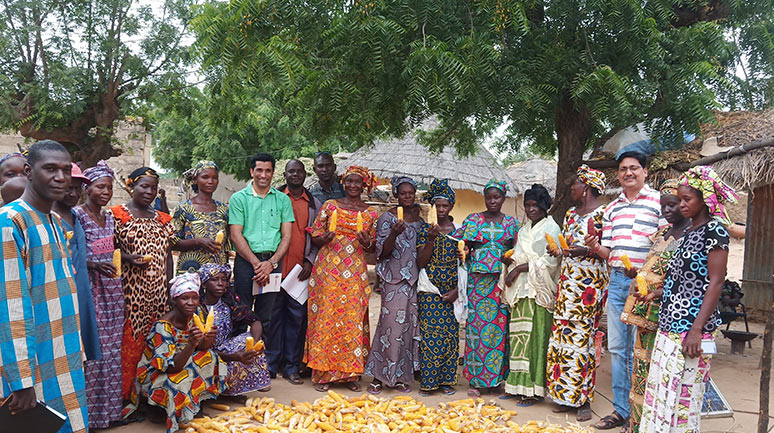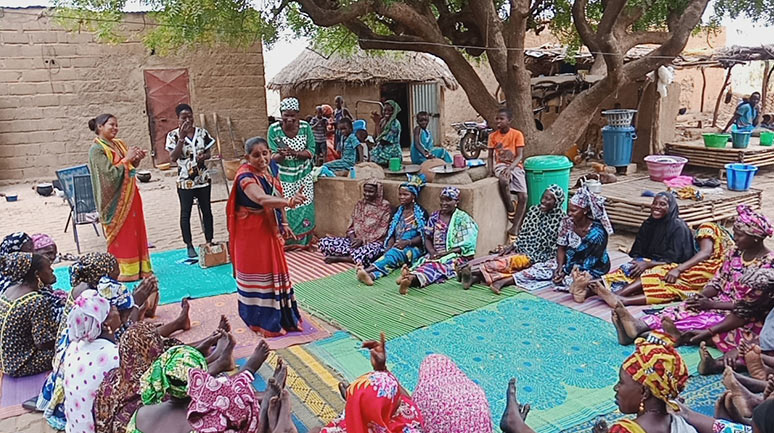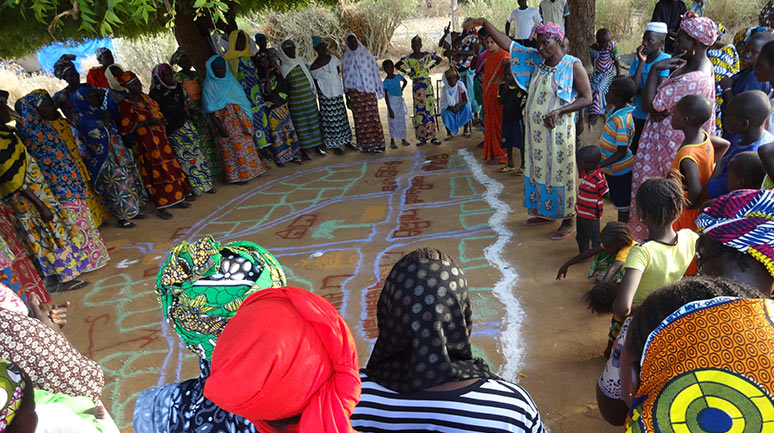Community to Community Learning: Rajasthan to Mali

Taking the successful models and lessons of women’s empowerment and rural economic development from the SHGs in India and applying these in Mali, a region facing similar environmental and socio-economic challenges, is an encouraging example of global collaboration and kinship

Meeting with the community, Marintoure village, Logo Kayes, Mali
T he Indo-Malian (Dholpur, Rajasthan, India, to Logo Kayes, Mali) Community to Community (C2C) learning for growth and development has been a journey of accomplishment.
In 2016, cross-organizational stakeholders from Camide1 and Virtue Ventures2 visited Manjari Foundation3 in India to study instances of women’s empowerment and rural economic development organizations that had successfully scaled up their initiatives to reach a large population. The objective was to see if applicable models, lessons or inspiration could be drawn from the Indian experience and replicated in Mali, a region facing similar environmental and socio-economic challenges.
The visit paved the way for interaction with SHGs members and for understanding the basic processes and impact of women-led institutions. The Manjari Foundation team oriented the visitors about the processes and protocols of community mobilization; the strategies for promotion of women-led institutions and other sustainable livelihood programmes that had been successfully implemented.
During the visit, the Mali team experienced India’s powerful, peer-driven, Self-Help Group (SHG) ecosystem and witnessed how the Manjari team integrated the SHG functionality in its livelihood development agenda, thereby creating its own unique SHG model.
The Camide team shared its willingness to replicate the same model in the Kayes region of Mali. A team from Manjari Foundation, it was decided, would visit Mali to understand the context and explore the opportunity of partnership.
A year later, the Manjari team, comprising technical staff and SHG members, arrived in rural Mali. Thus, 2017 marked the beginning of a true south-south collaboration, whereby the Indian women’s SHG model was being adapted to the Malian context and implemented through a powerful, experiential, peer-learning and peer role-modelling methodology. To our knowledge, this is a unique initiative, and no similar programme had ever been executed in West Africa.
After receiving trainings from Manjari Foundation, we are now capable of scaling up the women’s institution work in Mali. It’s a unique initiative across the country; we are fortunate and proud to partner with MF India. Language has not been a barrier, or obstacle, for them. Now our community is more equipped to fight against poverty.”
Alou Keita, The Director General, Camide
Context and Background
M ali is one of the least developed countries in the world. In 2018, it was at 182nd (out of 189 countries) in the United Nations Human Development Index. Ninety per cent of the population lives in the rural areas where poverty is the highest. As per the World Bank, 43 per cent of Malians live in ‘extreme poverty’, earning less than $1.25 per day.4 Eighty per cent of Mali depends on rain-fed agriculture, their major source of livelihood. This provides the greatest opportunity for development programmes. Mali ranks 157th out of 160 countries in the UN’s Gender Inequality Index5 , and the disparity between women and men is stark. Women face significantly higher barriers to education, employment and economic opportunities as compared to men. Hence, there is a need and an opportunity for women’s agricultural livelihood organizations in rural Mali to foster both economic growth and women’s empowerment.

Indian CRPs from India mobilizing women for SHGs in Keruane village, Logo Kayes, Mali
The Problem
A lthough many initiatives have been tried in Mali, there is a striking lack of strong, self-reliant models that truly empower women in the country. There are many reasons for this failure. Many of the programmes are often developed and supported by outside actors, based in Bamako or abroad, using western-designed models for which there is little local interest. The inception of these organizations is often driven by funding opportunities linked to time-bound projects; their implementation is led by expatriate technical advisors from western countries. Similarly, group methodologies used in underlying organizational structures are perceived as a necessary ‘means to the money’, rather than a road to self-reliance and empowerment.
Women CRPs from India, working with Malian women, to promote SHGs and cooperatives at the village level is a big initiative. I would like to congratulate both Manjari Foundation and Camide for doing such remarkable work.”
Anjani Kumar Sahay, Ambassador, Indian Embassy Bamako, Mali
As a result, village organizations in Mali tend to be patriarchal, political, led by top-down decision-making and created largely as administrative bodies, to receive and disburse project funding attributes, which inherently hinder women’s empowerment, cause distrust and conflict among stakeholders, and contribute to the overall fragility of the organization. Such women’s organizations cannot and did not achieve self-reliance because they were not created as going concerns grounded in purpose and local wants, ownership and leadership or founded on a model that fits the Malian context, culture and operational realities
Our Solution: Yeredeme Groups
T he overarching goal of our pilot was to create a local development model of rural women that could be replicable throughout Mali and other West African countries.
Yeredeme Groups, meaning SHGs, in Bambara, were a ground-breaking pilot programme for rural women’s empowerment, institution-building and livelihood development, involving technical partnership between Manjari Foundation, and Camide. The scope of the pilot was to validate Manjari Foundation’s innovative SHG model, which integrates livelihood development, financial intermediation, women’s empowerment and community development in the Malian context, and to adapt it into a model for the Sahel region. The pilot uses the human-centred design (HCD) approach, which puts the ‘users’ (rural women) at the centre of its research and development (R&D) process and involves them in problem-solving and solutions-development through an iterative, rapid, prototyping cycle during implementation. Using this approach, Camide and Manjari Foundation collect evidence-based data from the village women and the ecosystem stakeholders, to inform the model and methodology design for the region.

Social Mapping, Keruane village, Logo Kayes, Mali
Uniqueness of the Partnership
- Yere Ta and C2C learning: Our experience shows that people learn and adopt new practices easily if the contexts are similar. In this project, the women from Dholpur, Rajasthan, India, who had undergone the same transformative experiences and had emerged out of poverty and exclusion, stayed with the Malian women in their villages and shared their journey, thereby motivating the Malian women to step ahead and form groups that could empower them.
YERE TA KENE was a big success. According to me, for the first time, the Municipality of Logo is seen together in large numbers. I would like to thank Manjari Foundation, Camide and the entire CRPs team. They stayed in our villages, ate, sang and taught together, and showed us a new path for development. I have never met an NGO like them. I visited India also and learned a lot.”
Mohamed Coulibaly, Mayor, Logo, Mali
- Cross-learning through exposure and experience-sharing: As we know, seeing is believing. Thus, Yere Ta focused on cross-exposure of Malian women with the practices in India, wherein they interacted with women SHG members and witnessed the benefits of the programme as well as how rural women have come forward to enhance their well-being and socio-economic conditions.
- No imposition by each partner: Under this endeavour, Manjari Foundation has been focused on processes and driven by a belief of enabling partnership. What needed to be done was decided by the Camide team. The whole purpose is to share, orient and brainstorm with the audience or beneficiaries—a learning from the extensive experiences of working with Indian women’s institutions.
- Let the local partner take charge: Manjari engaged with the local partner from inception till completion of the programme. From the beginning, the know-how and the experiences of the local partner have always been well accounted for in the design because local partners have a better understanding of the context.
Table: Partnership: A Timeline
| Date | Partnership Initiatives |
|---|---|
| May 2017 | A Manjari Foundation professional travelled to Kayes for a first baseline assessment, in order to prepare for a larger intervention. |
| November 2017 | The Manjari Foundation team (four SHG members, two senior book-keepers and a senior rural development professional) spent 30 days in four Malian villages with the Camide team and set up the first 50 groups. |
| May 2018 | The Manjari Foundation team (six Indian SHG members, three senior group book-keepers and a senior rural development professional) spent 15 days in the four Malian villages with the Camide team, to evaluate the existing groups and set up the first Village Organization (VO). |
| October 2018 | A group of Malian SHG members, the Camide technical staff and the mayor of Commune du Logo travelled to India for a second exposure visit that focused on livelihood activities. Five Malian SHG members decided to pilot a chicken farm. |
| January–June 2019 | Local replication started (by Malian SHG women) in nine more villages |
| November 2019 | Two senior Manjari Foundation rural development professionals traveled to Mali to conduct an evaluation of the pilot to date. |
| February–March 2020 | The Manjari Foundation team (4 Indian Federation members, 3 senior professionals and a senior rural development professional) traveled to Mali to establish the women’s Federation in Commune du Logo. |
| by March 2020 | 1800 women were organized in 160 groups across 12 VOs and one Federation. An interactive map of the current groups and villages is available at: http://go.camide.org/cartegydlogo |
Learning and Experiences
- Acceptance by the community: The Manjari Foundation team witnessed an amazing community in Mali. The hospitality, acceptance, willingness, enthusiasm and zeal to learn and grow touched the team’s soul. The team got an opportunity to stay in the villages. Even though the villages were devoid of basic facilities—good housing, sanitation, internet—the team members never felt isolated because the heartfelt hospitality of the community removed thoughts of their back-home privileges.
- Language is no bar: Language is an important means to communicate; it helps to develop an understanding of other persons. The Malian community interacts in French and Bambara (local language). In the initial phase, it was exceedingly difficult to communicate and understand. However, after a few days, our community resource persons (CRPs) were successful in developing a unique bond with the Malian community, which facilitated understanding and learning. We developed the tools, the methodology and the associated activities; on implementation, it resulted in quick understanding and proper grasp, and assisted us in delivering the message. We have used games as an important tool for learning and training. This has not only resolved our language challenges but also helped in easy learning through games.
When we started, we were not so sure about the visible changes. After two years, however, we witnessed a tangible and transformative change in the lives of the Malian community in Logo Kayes. The Indian CRP methodology is a great initiative for socio-economic development of the African community. As per our experience, this is best suited for us."
Vincent Dawans, Representative, Virtue Ventures
- Peer learning: Manjari Foundation’s methodology involving SHG peer-learning and peer-role modelling is the cornerstone of its self-reliant model. Often, technical advice and capacity building in Mali is conducted by external experts, who instruct intermediary NGOs, not users, in a classroom setting. The Yeredeme Group model adopts a wholly unique peer-learning and role-modelling methodology in Mali, and validates its ability to inspire and teach rural women to lead and manage their own organizations and livelihood activities. Training programmes were held on book-keeping, group decision-making and organizational management, using a learning-by-doing approach. The peer-to-peer methodology legitimizes the model in Mali and propels its growth more efficiently and cost effectively than models that rely on Western expertise or support from capital city-based NGOs.
1 Camide, a Malian technical assistance and microfinance NGO based in Kayes (Western Mali), was officially registered in 2002. Camide began as a microfinance initiative in 1998 and has built a successful microfinance network of self-managed village banks called Benso Jamanu, which serves more than 70,000 rural customers in about 120 villages. Camide has invested in developing a women's economic empowerment methodology that works in the local context and can be scaled to cover the entire network of Benso Jamanu.
2 Virtue Ventures, an international development technical assistance social enterprise, uses innovation, entrepreneurship, business tools, and sound management practices to empower social-sector organizations to solve pressing social problems. Virtue Ventures has been working with Camide since 2009, to build capacity and support its efforts in finding an appropriate women’s empowerment model for Mali and the wider Sahel region.
3 Manjari Foundation, an Indian livelihoods NGO established by PRADAN, is renowned for its work in promoting a network of self-help groups (SHGs) in 2015 in Eastern Rajasthan. Manjari’s unique selling proposition (USP) is that it includes livelihoods development in the SHG model, which has been successfully scaled in India. Its replication is led by women SHG members themselves, a major competitive advantage over the technical support models that rely on external expertise.
4 World Bank
5 Human Development Indices and Indicators: 2018 Statistical Update: Mali" http://hdr.undp.org/en/content/gender-inequality-index


5 Comments
[…] 2016, cross-organizational stakeholders from Camide1 and Virtue Ventures2 visited Manjari Foundation3 in India to study instances of […]
Really great initiative taken by the Manjari for Bambara Mali. This will help to Malian Community development because Mali depends on rain-fed agriculture. Hence, there is a need and an opportunity for women’s agricultural livelihood organizations in rural Mali to foster both economic growth and women’s empowerment. This activity will help to develop them.
Mr. Anjani Kumar Sahay, Ambassador, Indian Embassy Bamako, Mali apricated this initiative. Best wises for Manjari and Mali Team.
दो अलग देशों के साथ के अनुभव को पीयर लर्निंग की दृष्टि से पढ़कर बहुत अच्छा लगा. अब तो इस बारे में और जानने की आवश्यकता अनुभव हो रही है. सामुदायिक शिक्षा के क्षेत्र में यह अनुभव मील का पत्थर सिद्ध होगा.
दो अलग देशों के साथ के अनुभव को पीयर लर्निंग की दृष्टि से पढ़कर बहुत अच्छा लगा. अब तो इस बारे में और जानने की आवश्यकता अनुभव हो रही है. सामुदायिक शिक्षा के क्षेत्र में यह अनुभव मील का पत्थर सिद्ध होगा.
I would like to thank you Sumita Kasana for helping us to publish our work in Mali.